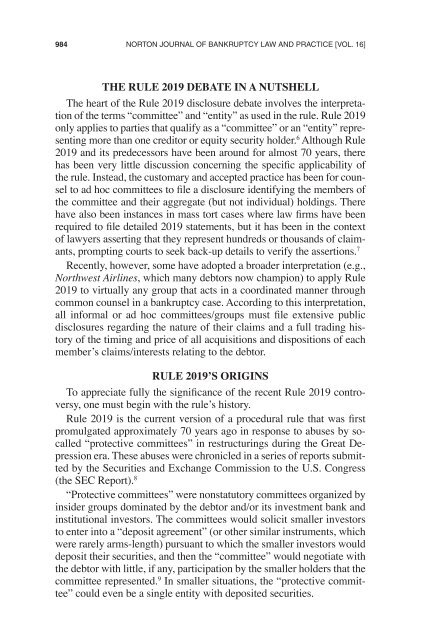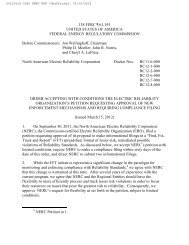Ad Hoc Committees and the Misuse of Bankruptcy Rule 2019
Ad Hoc Committees and the Misuse of Bankruptcy Rule 2019
Ad Hoc Committees and the Misuse of Bankruptcy Rule 2019
Create successful ePaper yourself
Turn your PDF publications into a flip-book with our unique Google optimized e-Paper software.
984 Norton Journal <strong>of</strong> <strong>Bankruptcy</strong> Law <strong>and</strong> Practice [Vol. 16]<br />
THE RULE <strong>2019</strong> DEBATE IN A NUTSHELL<br />
The heart <strong>of</strong> <strong>the</strong> <strong>Rule</strong> <strong>2019</strong> disclosure debate involves <strong>the</strong> interpretation<br />
<strong>of</strong> <strong>the</strong> terms “committee” <strong>and</strong> “entity” as used in <strong>the</strong> rule. <strong>Rule</strong> <strong>2019</strong><br />
only applies to parties that qualify as a “committee” or an “entity” representing<br />
more than one creditor or equity security holder. 6 Although <strong>Rule</strong><br />
<strong>2019</strong> <strong>and</strong> its predecessors have been around for almost 70 years, <strong>the</strong>re<br />
has been very little discussion concerning <strong>the</strong> specific applicability <strong>of</strong><br />
<strong>the</strong> rule. Instead, <strong>the</strong> customary <strong>and</strong> accepted practice has been for counsel<br />
to ad hoc committees to file a disclosure identifying <strong>the</strong> members <strong>of</strong><br />
<strong>the</strong> committee <strong>and</strong> <strong>the</strong>ir aggregate (but not individual) holdings. There<br />
have also been instances in mass tort cases where law firms have been<br />
required to file detailed <strong>2019</strong> statements, but it has been in <strong>the</strong> context<br />
<strong>of</strong> lawyers asserting that <strong>the</strong>y represent hundreds or thous<strong>and</strong>s <strong>of</strong> claimants,<br />
prompting courts to seek back-up details to verify <strong>the</strong> assertions. 7<br />
Recently, however, some have adopted a broader interpretation (e.g.,<br />
Northwest Airlines, which many debtors now champion) to apply <strong>Rule</strong><br />
<strong>2019</strong> to virtually any group that acts in a coordinated manner through<br />
common counsel in a bankruptcy case. According to this interpretation,<br />
all informal or ad hoc committees/groups must file extensive public<br />
disclosures regarding <strong>the</strong> nature <strong>of</strong> <strong>the</strong>ir claims <strong>and</strong> a full trading history<br />
<strong>of</strong> <strong>the</strong> timing <strong>and</strong> price <strong>of</strong> all acquisitions <strong>and</strong> dispositions <strong>of</strong> each<br />
member’s claims/interests relating to <strong>the</strong> debtor.<br />
RULE <strong>2019</strong>’S ORIGINS<br />
To appreciate fully <strong>the</strong> significance <strong>of</strong> <strong>the</strong> recent <strong>Rule</strong> <strong>2019</strong> controversy,<br />
one must begin with <strong>the</strong> rule’s history.<br />
<strong>Rule</strong> <strong>2019</strong> is <strong>the</strong> current version <strong>of</strong> a procedural rule that was first<br />
promulgated approximately 70 years ago in response to abuses by socalled<br />
“protective committees” in restructurings during <strong>the</strong> Great Depression<br />
era. These abuses were chronicled in a series <strong>of</strong> reports submitted<br />
by <strong>the</strong> Securities <strong>and</strong> Exchange Commission to <strong>the</strong> U.S. Congress<br />
(<strong>the</strong> SEC Report). 8<br />
“Protective committees” were nonstatutory committees organized by<br />
insider groups dominated by <strong>the</strong> debtor <strong>and</strong>/or its investment bank <strong>and</strong><br />
institutional investors. The committees would solicit smaller investors<br />
to enter into a “deposit agreement” (or o<strong>the</strong>r similar instruments, which<br />
were rarely arms-length) pursuant to which <strong>the</strong> smaller investors would<br />
deposit <strong>the</strong>ir securities, <strong>and</strong> <strong>the</strong>n <strong>the</strong> “committee” would negotiate with<br />
<strong>the</strong> debtor with little, if any, participation by <strong>the</strong> smaller holders that <strong>the</strong><br />
committee represented. 9 In smaller situations, <strong>the</strong> “protective committee”<br />
could even be a single entity with deposited securities.



